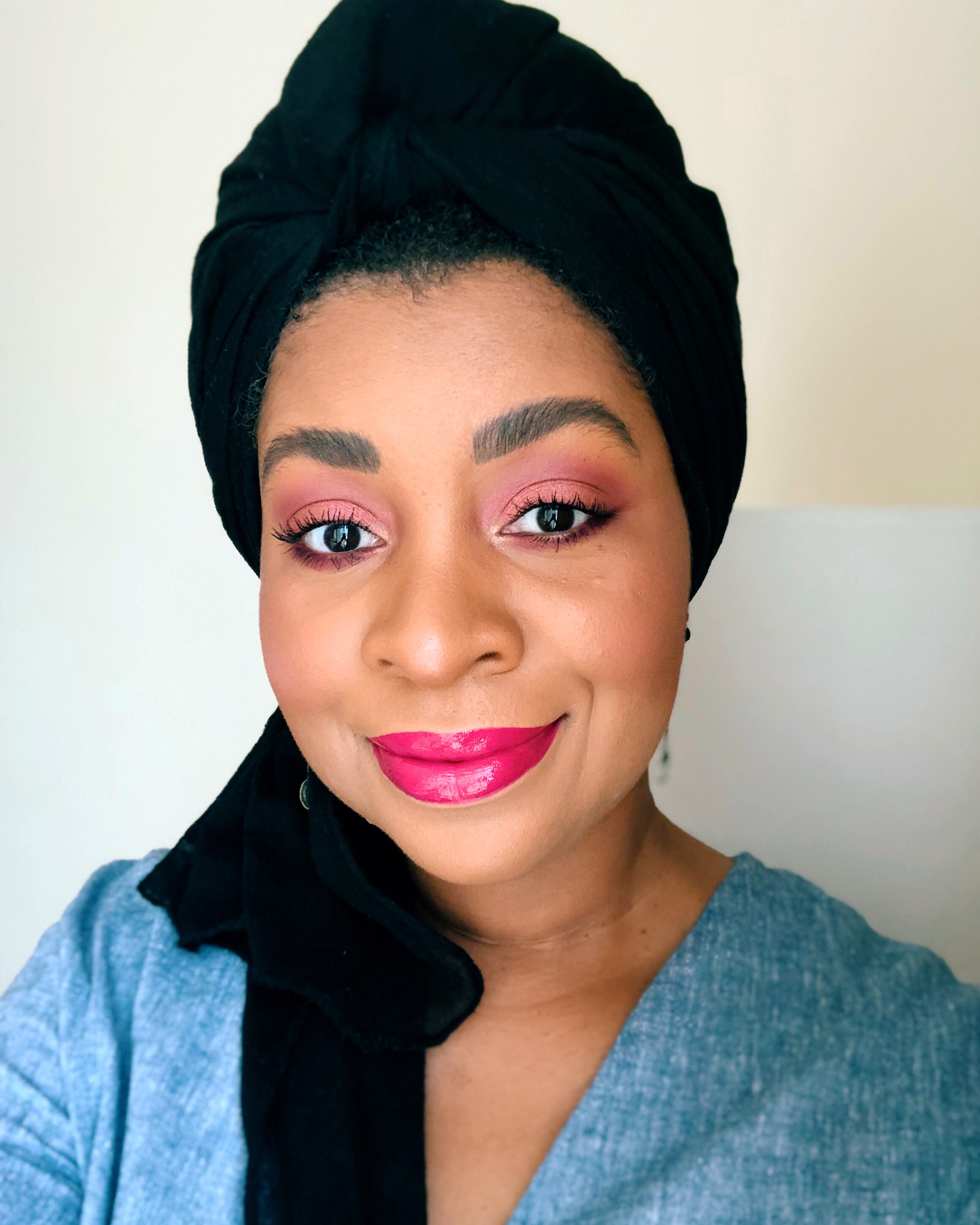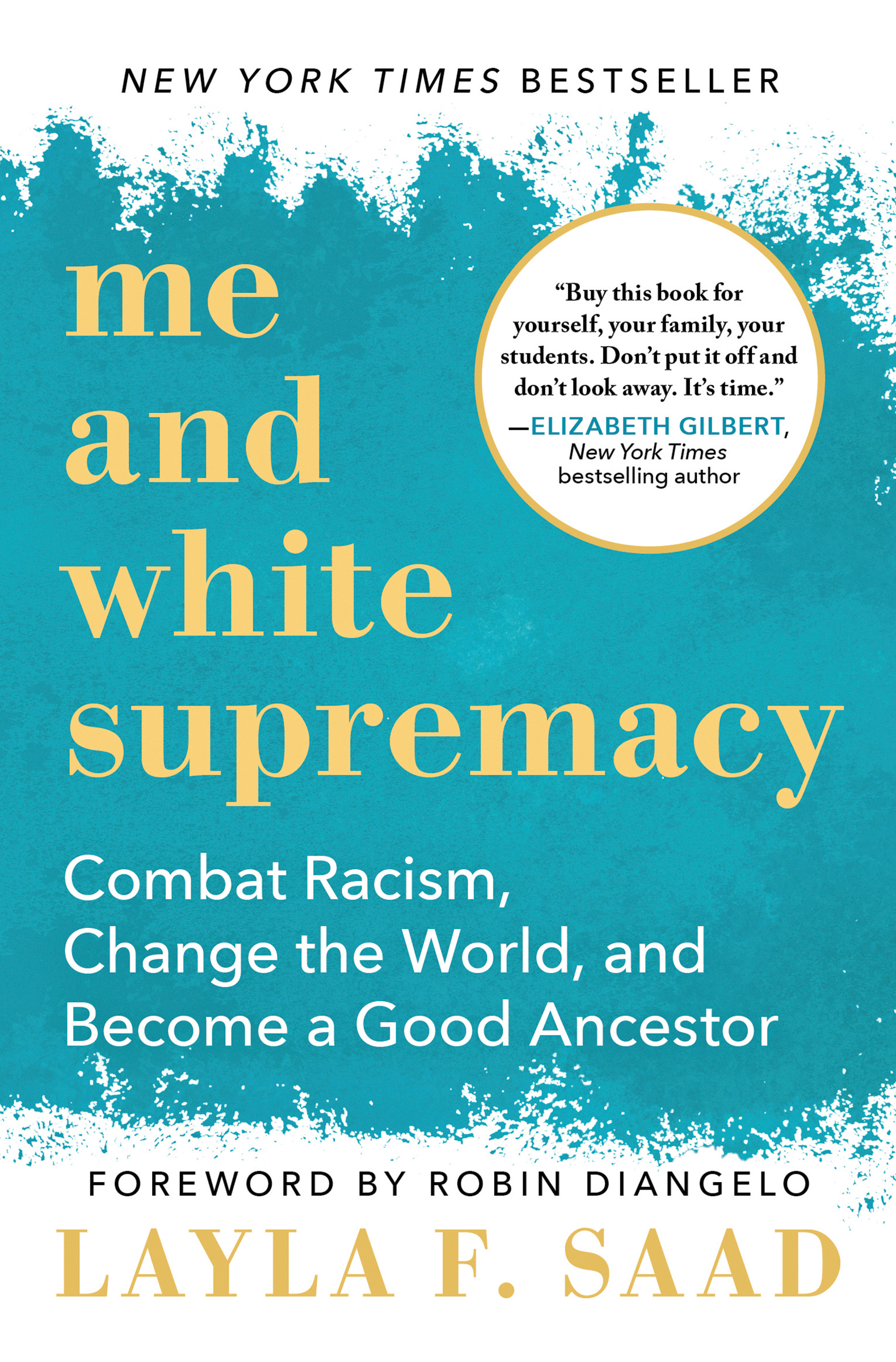
When Layla F. Saad thinks back to seeing images from the Unite the Right rally in Charlottesville in 2017, her skin prickles. “I think about the pure hatred that was in those men’s eyes, and see the connection that the hate is directed specifically at people who look like me,” she says. Saad, who was working as a life coach before she became an antiracist educator, was compelled to write a blog post in response to Charlottesville, addressing white women working in her industry and calling out their failure to combat white supremacy. From that blog post came her viral 28-day challenge on Instagram, #meandwhitesupremacy, where she encouraged followers to answer simple yet direct questions about their complicity in white supremacy, and a digital anti-racism workbook, which was downloaded 100,000 times in six months in 2018.
Saad’s book Me and White Supremacy, published in January 2020, encourages readers to carry on the challenge and write a daily journal in responses to prompts like “What have you learned about your white privilege that makes you feel uncomfortable?” and “In what ways have you been apathetic when it comes to racism?” It’s one of a selection of antiracism works that have gained significant attention as the Black Lives Matter movement surged in the aftermath of the killing of George Floyd.
Saad says that her intersecting identities and experiences as an East African, Arab, British, Black Muslim woman, who was born and raised in the U.K. and now lives in Qatar, have given her a unique perspective “to look at the different ways that white supremacy shows up, in ways we’re not even thinking about.” TIME spoke with Saad about the response to her work in the current context, her advice for Black communities, and what doing anti-racist work really looks like beyond performative allyship.
TIME: Me and White Supremacy was originally an Instagram challenge that you created, where you encouraged people to think through and reflect on their racist thoughts and behaviors. How would you define white supremacy and what do you think some of the misperceptions are about it?
Saad: I think people hear that word and the image conjured in their minds is the men marching in Charlottesville. And they’re like, “I’m not like that, I’m definitely not bad.” But white supremacy is about this idea, this belief, this ideology that people who are white or who look white are superior to people of other races, and therefore they deserve to be dominant over people of other races. And that dominance shows up in various different ways. It showed up centuries ago with genocide and enslavement and colonization. But it still shows up today, in interpersonal relationships, in what we see as the norm in the media, or the norm in companies, or the norm in schools. And so dominance doesn’t have to just be enslavement.
Did you write the book with an intended audience in mind?
I believe anti-racism work is work that all people who have white privilege have the responsibility to do. I really wrote it for the people who self-identify or consciously think of themselves as people who either want to show up in allyship or believe that they are allies. I wrote it with the full understanding that even those well-intended, well-meaning people are going to be really upset by some of the things that I write about, but at least they have the willingness and the desire to look within themselves.
There’s such a huge difference between someone who reads the book, and someone who does the book. Reading the book really is about taking in information, but really still staying at a surface level and still remaining separate from white supremacy. The act of journaling alongside it really requires you to look only at yourself and to take self responsibility for the ways that you have had racist thoughts, have racist beliefs, done racist things, even when you weren’t meaning to.
Following the killings of George Floyd, Ahmaud Arbery, Breonna Taylor and Tony McDade among several other Black men and women in the U.S., your book is one of several anti-racist books that people have sought out. How do you feel about that response to your work in light of the current context?
On the one hand, I’m so glad that so many people are finally turning to these resources and these works. And at the same time, I feel a sense of ambivalence. There are so many books on anti-racism, not just the ones that are currently on the bestsellers lists, but books that span back decades. This has been an ongoing conversation for so long.
I recently saw a white woman who posted about how when the Black Lives Matter protests begun, she bought my book and put out a note saying she was going to run a book circle with Me and White Supremacy. She initially had 55 people sign up—two weeks later, everyone’s disappeared, and there’s only five people left who are still showing up consistently.
So that rush and then apathy returning is why I have mixed feelings about it. It’s easy to buy a book, and it’s easy to say Black Lives Matter, and it’s easy to say, “I’m going to try to do the work.” It’s an entirely different thing to do it. And to do it when the hype is over, the news cycle has moved on, and you’re not getting rewarded for being so brave for saying Black Lives Matter. Now you’re just having to do the nitty gritty work — that’s where the real work is.

After events and protests in the U.S., there were several protests around the world, addressing racial injustice and white supremacy in individual countries. Do you think the Black Lives Matter movement in 2020 is different to anything that has preceded it?
In my lifetime, we haven’t seen anything like what we saw these past few months, across the United States and also across the world. I don’t ever want to underplay that. People are feeling encouraged and more confident in not staying quiet anymore, and I think that is amazing.
Of course, we’re in this hyper connected world online now. I think that’s why the Black Lives Matter protests this year took off in the way that they hadn’t before globally because people are seeing things happening in other countries, and seeing how it shows up in their own countries. White supremacy is one of those forces that has shaped the world itself in ways that are just very powerful and very, very harmful. And so it’s never not present.
Many Black people in particular, as well as Indigenous people and people of color, have spoken about the exhaustion of being confronted with white fragility or white guilt in recent weeks. Do you have any advice for these communities?
During the protests that followed in the first two weeks after George Floyd’s murder, I think half a million people started following my Instagram account. That was very overwhelming for me. We had masses of white people coming into our space with a conscious desire to want to learn, but also with unexamined anti-Blackness and not having the skills and understanding of how to go into our spaces without disrespecting us.
Having white privilege still means that you can actually switch off and being Black means you cannot. The advice that I would give to Black people especially, and indigenous and people of color, is that your self care really does have to come first. While this moment of this movement that we’re in is really unprecedented, this work has been going on for decades, centuries, and it will continue to do so. So you can’t burn yourself out right now just because more people are interested in hearing from us. It’s also not your responsibility to teach white people about whiteness, and about white supremacy.
For Black people especially, one of the ways that we practice anti-racism is learning how to center ourselves, our joy, our self care, our mental wellbeing, our physical health. One of the things that’s so traumatizing from this is recognizing that Black lives only seem to matter when Black people are being killed in the most violent and horrific ways, and that we can only get attention when we are pimping our pain. When we say Black Lives Matter, it’s the life of Black people that matters.
Your book talks about the commitment and the discipline of doing this anti-racist work. How would you define that and what are some of the ways that people can do that beyond reading books like your own?
The metaphor I use is that every morning you wake up and you hit the reset button on “how can I show up in anti-racist allyship today?” That includes things like learning and educating yourself, but also seeing in what ways white supremacy is showing up as you’re moving through the day, in what ways you are complicit in maintaining it, and therefore in what ways can you disrupt it. It’s about really taking mindful responsibility for your everyday lived life, and not seeing anti-racism as something that you do when you have a bit of extra time on the side.
We are now nearly two months on from when the initial protests started. How do you feel about the future of the Black Lives Matter movement, and where do you see it going?
My hope is that now as Black Lives Matter becomes more mainstream that white and non-Black people really take on the mantle as well and alleviate the burden from Black people, from us having to shout into the void, that Black lives matter. I think that’s a very long way off, because I don’t know any time when white people were in interaction with Black people that Black lives did matter. So that’s the world that we’re building towards, and we’ve never seen it before. We don’t know what it looks like, we have no blueprint for it. We really have to use our imaginations and our creativity to work towards it. But we have to work towards it together.
Your next project is a children’s version of Me and White Supremacy. How can we equip children to talk about race and white supremacy?
I initially thought this would be an interpretation or translation of the adult version for younger readers, but I’ve realized this book has to be for all kids of all races and not just for white kids, which then changes everything. It’s a huge responsibility. Young kids are like sponges—they absorb everything, so this work has to really be done with care. Some of my intentions and aims are to equip them with context, history, language and critical thinking skills to really understand how white supremacy operates. It’s about giving kids a shared language to be able to grow into adults who can talk about race and dismantling white supremacy together.
As a Black kid, I had to learn about race from age seven. So I’ve been aware of race and racism my whole life. Many white adults are just learning it today. So we’re not on the same level at all. And I hope that through this book, kids of all races can have different conversations and create a different world.
This interview has been lightly edited and condensed for clarity.
More Must-Reads from TIME
- Cybersecurity Experts Are Sounding the Alarm on DOGE
- Meet the 2025 Women of the Year
- The Harsh Truth About Disability Inclusion
- Why Do More Young Adults Have Cancer?
- Colman Domingo Leads With Radical Love
- How to Get Better at Doing Things Alone
- Michelle Zauner Stares Down the Darkness
Contact us at letters@time.com